Don National School - Ireland
Region: Ballaghadeeren, County Roscommon
Other schools in the Quad Blog: Colégio do Minho (Portugal), Escola Serralavella (Spain), ZS Korunovacni (Czech Republic)
Creative Connections Project: Exploring individual and collective identities
The Don National School is a small rural school located six kilometres east of Ballaghaderreen, County Roscommon in the West of Ireland. It caters for boys and girls from four years (infants) to 12/13 years (sixth class). It is a Catholic school under the patronage of the Catholic Church. The school receives funding from Delivering Equality of Opportunity in Schools (DEIS). Attendance in the school is very good. Its mission statement states that it ‘strives to promote a happy and positive educational environment’. The school supports the principles of equality, diversity and inclusion. The Catholic ethos is valued and promoted throughout the school. The participating Creative Connections teacher is also the Principal; she is one of three teachers. As both Principal and teacher she has established a very positive and welcoming school climate and is also a very dynamic curricular leader. She monitors the quality of teaching and learning in the school in an open and sensitive manner.
The Creative Connections Project
The Principal teaches across three classes, comprising of a blend of 4th 5th and 6th class pupils. She approached the Creative Connections project from a cross curricular perspective. In exploring the European and Citizenship aspects of the project she felt the pupils had a basic knowledge of Europe through history and geography.
The teacher’s comment:
They would have known a lot through geography, history, general knowledge types of questions; you know, various library quizzes and that kind of thing and of course going on the holiday.
In her view, the pupils’ awareness of the EU system was at a basic level.
The teacher’s comment on EU awareness:
They would have quite a good understanding of what the EU was in the sense that maybe it was made up of so many countries and they would have gone into the core EU countries from a long time ago…we’ll say Britain and France and all of that and probably the physical boundaries say mountains and that kind of thing; the rivers and capital cities.
On the other hand the Principal found that the pupils had little awareness of issues of Citizenship and Identity. For the children exploring National and European Identity was quite challenging.
The teacher’s comment:
Getting a handle on their own self-identity was very difficult. It was very abstract and I know we do a lot about identity in Social, Personal and Health Education (SPHE) but it is more our personal identity, so getting a grip on our being able to articulate what it was like to be Irish was difficult in itself so that was the first thing that had to happen.
As the Principal was both the Creative Connections participating teacher and also the Principal of the school, she attended two training days in the National College of Art and Design (NCAD). The training sessions included a technical training day whereby participant teachers were instructed on the various technical aspects of how to use and navigate the Creative Connections website and upload pupils’ artwork to the appropriate areas. The second session focused on methodology and the curriculum material that the participant teachers could use to deliver the Creative Connections programme in the classroom context. Over the duration of the project, the Creative Connections team in NCAD created curriculum-training materials, specific to the needs of the projects participant pupils and teachers. Also generic resources were created and shared with the Creative Connections participant teachers in the partner countries.
The Project in Action
As the school is situated in a rural environment, the children are surrounded by nature and have a huge affinity with their immediate surroundings. Their local environment was a constant reference that permeated the exploration of personal identity. Mapping a place and the children’s reflections on living in a rural community influenced both the art process and the class discussion. The Principal identified this as a meaningful way in, in which to explore individual and collective identities and noted that this action has ‘made them proud of their own heritage/uniqueness’.
In order to support the teacher, as she was not an art specialist, two members of the National College of Art and Design Creative Connections Irish team facilitated a daylong printmaking workshop with the children. The workshop was underpinned by an exploration of the Irish artist Alice Maher’s work.
Prior to it commencing the children were asked to establish what they felt was unique about the place they lived in and to describe how living in the countryside differs to that of life in the city. The children offered up a range of insightful responses that encapsulated their understanding of being from a rural community, as articulated a pupil aged 12.
Pupil comment:
I think the landscape is tremendous because you can see all your neighbours houses and can see all the land all over the hills. At the back of my house is a ring fort. It is very old and all and there are other ones in my neighbours fields.
The children’s written responses about living in a rural environment were printed on to tracing paper, which they then constructed into personalised ‘identity envelopes.’ The children also created a series of observation drawings and mono-prints, based on found objects within their environment, through the exploration of line, shape, texture and pattern.
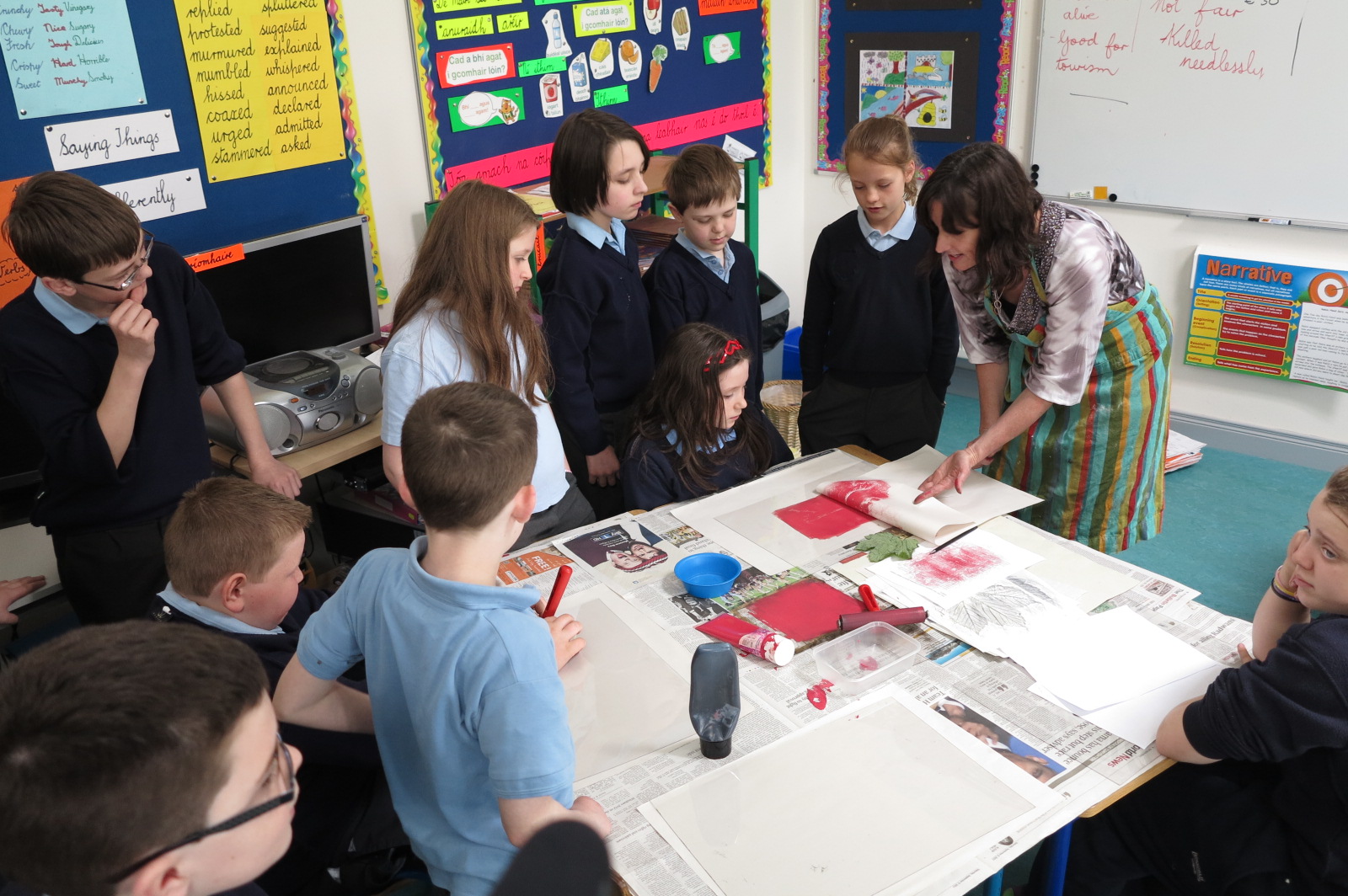
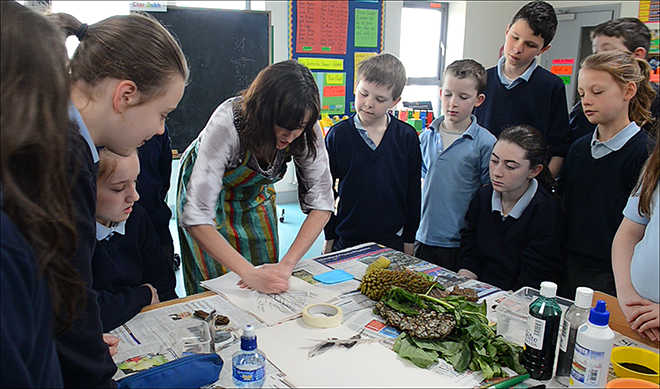
‘Being European’
As a starting point for the project the Principal facilitated her pupils in exploring their Irish identity by asking them to select a range of objects from home that symbolised the self. In class each child spoke about the significance of the object or image that they had sourced and presented it to their peers as a context in which to represent their own identity. Using a variety of drawing materials the children then began to explore the significance of their home environment in terms of influencing their identity. The Principal felt that these actions were an effective way to crystallise their understanding of what it meant to be Irish, prior to unpacking the more complex and abstract concept of being European.
The teacher’s comment:
Firstly they had to quantify and explore what their Irish Identity was and what being a citizen of Ireland means, this took a long time and had to be explored in depth before they could attempt to explore European Identity…from that they moved forward to explore their European-ness using Ireland as a base level.
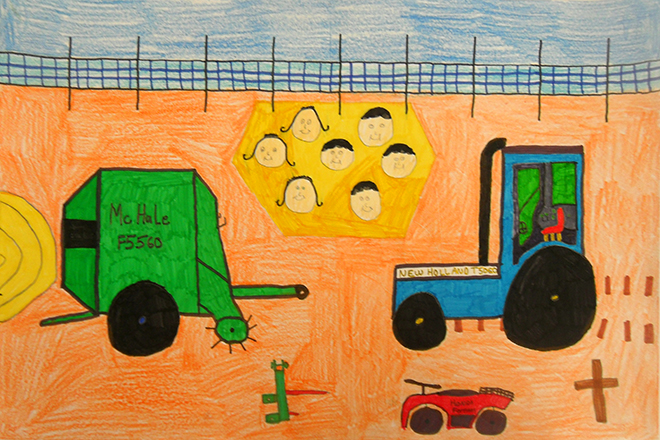
The teacher observed that the blogging process also enhanced the children’s understanding and sense of connection with Europe, in particular the conversations that were generated between the Spanish Catalan School and her pupils. The children connected and identified similarities on many different levels including indigenous language. The link with the Spanish school triggered an interest in the minority language, because there was Catalan spoken, so they made the connection that Irish and Catalan were something similar. Pastimes, music, pets and football were also discussed amongst the children and their European peers. The teacher reflected that the children ‘have developed more empathy with their counterparts at their own age level’ through engaging in the quad blogging process and noted that the excitement was heightened by the pupils anticipation of what responses would be there the next day when visiting the blogging area of the Creative Connections website.
Contemporary art as a space for learning - Artists used as a stimulus for themes
The contemporary art aspect of the Connected Gallery and the practical art component of the Creative Connections project was a challenge for the Principal. The Principal began the project with considerations on how to portray Irish Identity:
How will we explore that through the art media; how we would explore their identity – even their Irish identity first and then exploring their Irish identity and looking really at what we think of Ireland; what are the stereotypes that make us think of Ireland?’
Interestingly on examining David Cerny’s Entropa, the children were horrified at Ireland being portrayed as a sod of turf in his work ‘they love the bog and they love all that aspect of it but they just didn’t like that.’ The significance of the bog was a source of inspiration for the children’s artwork as articulated and visually represented in one child’s artwork and reflective statement detailed below.
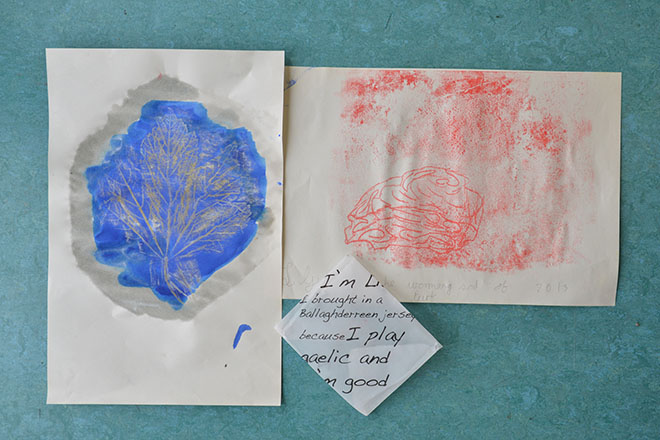
Above is a painting of a sod of turf. Burning turf is a traditional Irish way of heating houses. Turf comes from a bog. First, turf is cut from the bog around April or May. Traditionally turf was cut by a sleán but nowadays it is usually cut by a tractor. Then it is turned in late June. About a week later it is footed. About three weeks later it is clamped. Clamping is when you leave your turf in a big pile to dry out. The whole process is back breaking work. Finally the hopefully bone-dry turf is brought home to heat the house during the cold winter.
The Principal noted that the Creative Connections Connected Gallery was very effective in drawing out the children’s voices and generating discussion around Europe. In the initial stages the pupils connected with the Portuguese piece The Family Gathering and recognised that families are the same the whole world over. They moved onto explore what it was like being part of Europe and really that ‘we are all very much the same’. They were saying that now we have the same currency; although they recognised that the language was different.
On exploring and responding to the diverse range of contemporary artists that the children viewed through the Connected Gallery one child noted:
It could give you ideas in your head; like what were you going to do in art. You could say oh I’m going to draw a picture on a piece of paper but then you might decide to do it on your arm or on the wall over there or something like that.
The work of artist Alice Maher was a favourite amongst the pupils. One child commented that Maher’s work is:
… a bit like a puzzle, because you have to think about it before you can figure it out and the thing on her arm looks like she is connected to nature.
ThroughAlice Maher’s work the children contextualised how the landscape can be used as a constant source of inspiration, to represent memory and capture a sense of place. The children examined how Alice’s practice as an artist, presents to the viewer aspects of the natural environment in unusual contexts and often captures her interaction with the land from a child’s perspective.
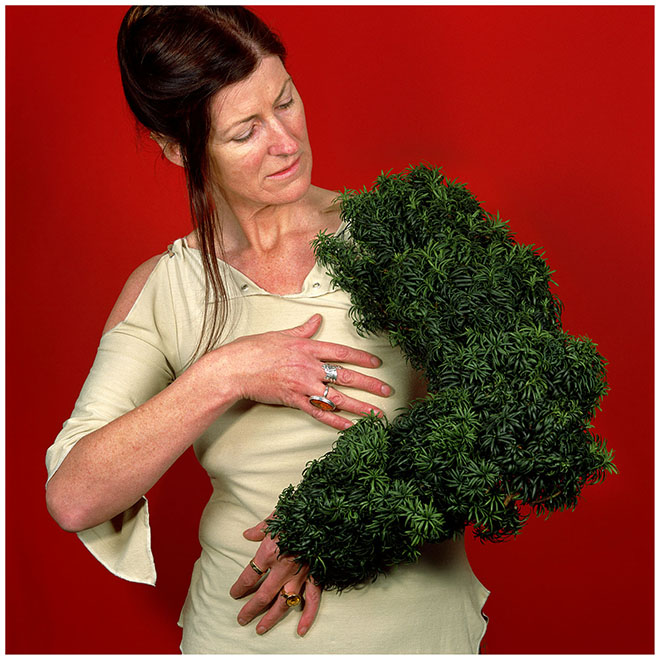
In response to viewing Maher’s work Limb the children observed the following:
She has isolated her arm from her body. She is using herself as art.
Nature grows in the country and there it’s growing on her, ‘wearing nature’ is the title I would choose.
She might of planted a tree when she was younger and saw it grow all through her life and she’s not afraid to let people know she likes nature so much she wants to be with nature everywhere she goes.
Reflections
The Principal noted that time constraints and the Creative Connections website design and usability impinged on the fluidity of the conversations between the children and their European counterparts.
The teacher’s comment:
The logging in of each individual child by me took loads of time, constantly changing passwords etc.
At one stage the project was brought to a standstill as a result of a pupil posting up an inappropriate comment relating to another child.
The challenge of making sure what they posted was appropriate was a constant concern for the Principal. The children at the Don’s School observed that their other quad blogging partners on the site were initially very slow to engage, it often took days and weeks before images would be uploaded to the site. Due to this, it was hard to keep the momentum and the children became disheartened when there was very little commentary about the work they had uploaded. In contrast the children connected on a very personal level with the Spanish Catalan School, as there was energetic dialogue and responses between both the Irish and Spanish children through the Quad Blogging interaction. The Principal also noted that the conversations generated by the pupils in the classroom had a direct influence in developing their confidence and oral language skills when blogging with their European peers.
The Principal observed that the children’s voices were mostly captured through their art production and by their ‘exploration of themes through charcoal, paint, print and digital media’. Looking at and responding to the Artist’s work on the Creative Connections Connected Gallery also generated interesting and varied opinions amongst the class.
In reflection the Principal felt that the children’s understanding of Europe was not significantly changed but overall she thought the project was hugely rewarding in terms of her own professional practice and the children’s level of engagement with contemporary art practice, ICT, connecting with their European counterparts in Spain and unpacking the concept of National and European Identity.
The teacher’s reflection:
I wouldn’t have been quad blogging with the children and we would never have made that European connection if not for Creative Connections and that was hugely rewarding and certainly we wouldn’t have made that personal connection with the other countries so that is a link and it is just such a pity too that that link will be severed now just when it has come on board.
DEIS the Action Plan for Educational Inclusion, was launched in May 2005 and is the Department of Education and Skills policy instrument to address educational disadvantage. The action plan focuses on addressing and prioritising the educational needs of children and young people from disadvantaged communities, from pre-school through second-level education (3 to 18 years).DEIS provides for a standardized system for identifying levels of disadvantage and an integrated School Support Program (SSP). 194 second level schools in Ireland are included in the programme.http://www.education.ie/en/Schools-Colleges/Services/DEIS-Delivering-Equality-of-Opportunity-in-Schools-/#sthash.4sAoOJqJ.dpuf


